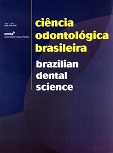Avaliação da densidade de potência e do espectro de luz de fotoativadores usados em consultórios odontológicos
DOI:
https://doi.org/10.14295/bds.2008.v11i4.675Resumo
O estudo avaliou a densidade de potência e o espectro de diferentes fotoativadores usados em consultórios odontológicos de Piracicaba, SP. A potência (mW) dos fotoativadores foi mensurada com potenciômetro (Ophir 10A-V2-SH; Ophir Optronics). O diâmetro da ponta do aparelho fotoativador foi calculado e a área de emissão de luz mensurada (πr2). Posteriormente verificou-se a densidade de potência (irradiância) por meio de cálculo matemático (potência/ área). O espectro de luz emitido pela fotoativador foi obtido com espectrômetro (USB 2000; Ocean), para a caracterização dos espectros e mensuração da irradiância conforme a ISO/TS:10650 por meio de cálculos integrais das áreas nas regiões: 400 a 515nm, 190 a 400nm e acima de 515nm. Os consultórios foram classificados de acordo com o preço praticado para uma face de restauração de compósito: valor mínimo de R$50,00 (consultório nível C); de R$50,00 até R$70,00 (nível B); acima de R$70,00 (nível A); consultório de serviço público; e de planos odontológicos. Na região de 400-515nm, o nível A apresentou 30% de fotoativadores abaixo de 300mW/cm2; o nível B e clínicas de convênios apresentaram 50%. O nível C registrou 40%, e serviço público mostrou 20%. Na região 190-400nm não foi verificado fotoativadores fora da norma, em nenhum nível. Para a região acima de 515nm, o nível A mostrou 20% e os níveis B e C registraram 10% dos fotoativadores acima de 50mW/cm2. Em todos os níveis, a densidade de potência dos fotoativadores não estava de acordo com o recomendado pela ISO/TS: 10650.
Downloads
Downloads
Publicado
Como Citar
Edição
Seção
Licença
TRANSFERÊNCIA DE DIREITOS AUTORAIS E DECLARAÇÃO DE RESPONSABILIDADE
Toda a propriedade de direitos autorais do artigo "____________________________________________________________________" é transferido do autor(es) para a CIÊNCIA ODONTOLÓGICA BRASILEIRA, no caso do trabalho ser publicado. O artigo não foi publicado em outro lugar e não foi submetido simultaneamente para publicação em outra revista.
Vimos por meio deste, atestar que trabalho é original e não apresenta dados manipulados, fraude ou plágio. Fizemos contribuição científica significativa para o estudo e estamos cientes dos dados apresentados e de acordo com a versão final do artigo. Assumimos total responsabilidade pelos aspectos éticos do estudo.
Este texto deve ser impresso e assinado por todos os autores. A versão digitalizada deverá ser apresentada como arquivo suplementar durante o processo de submissão.




























